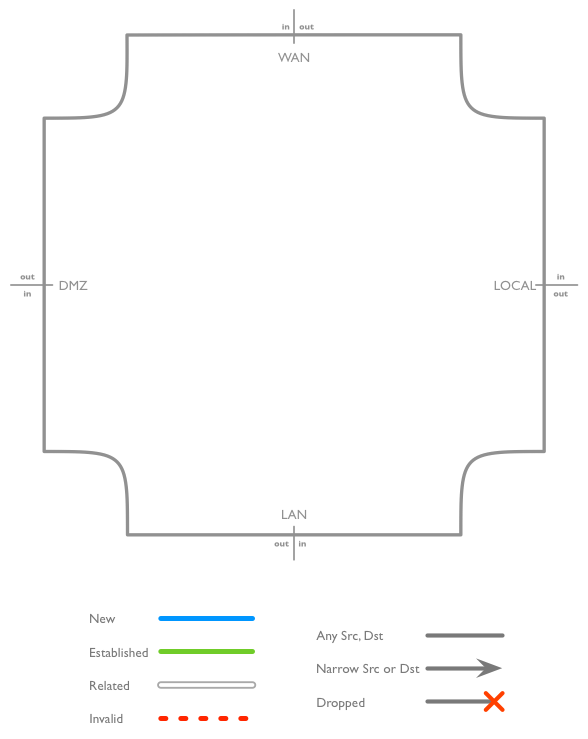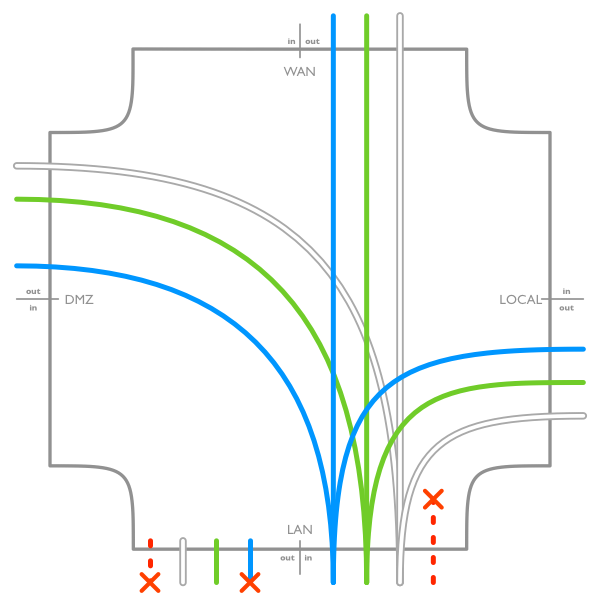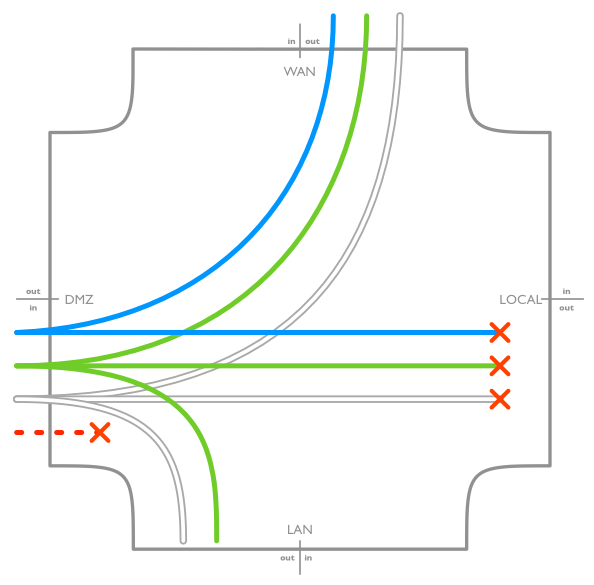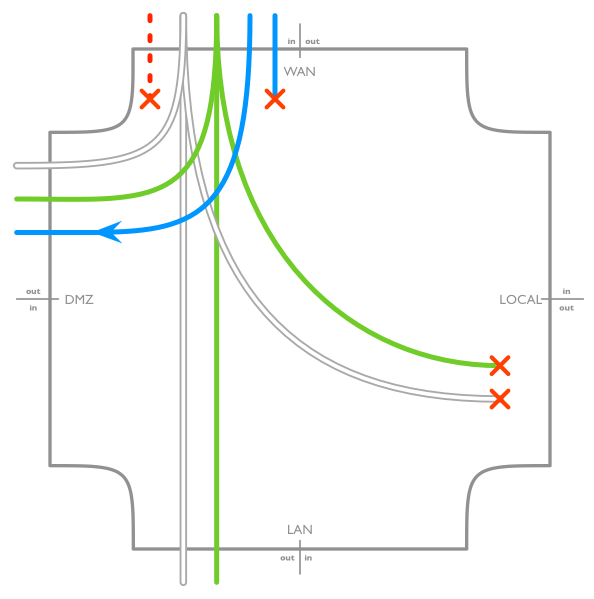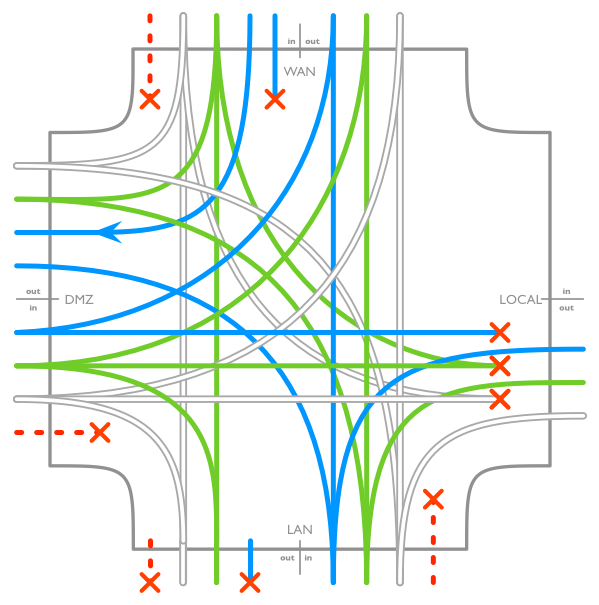THIS IS A DRAFT. DO NOT USE for constructing a production firewall configuration.
There are a few templates on the Internet for configuring firewall rules on Ubiquiti EdgeRouter but no from-scratch guide which may be preferred for better understanding. Also, for visual people at least some imagery may be helpful.
As usual, there are many way to skin a cat. Although there are good practices for configuring firewall rules, there is not a best one. Below is a way, to approach the task, without any claims of it's quality or fitness.
While presenting configuration examples in this write-up, the configuration code is simplified to capture the concepts. In firewall riles disabled filters are not shown, unless relevant for understanding. Other lines not relevant in a paragraph context are omitted as well. Finally, empty bracket sequences are also dropped.
This write-up walks through a SOHO firewall rules configuration reasoning. It assumes a SOHO setup on EdgeRouter POE with three networks: LAN, WAN, and DMZ. The LAN network is on the single Ethernet connection on eth0 port of the router. The WAN network is essentially an Ethernet link up to an ISP port via eth1 port. There are not more than three devices on DMZ in this example, so we will use the build-in switch for that purpose. The eth2, eth3, and eth4 ports are assigned to switch0 interface and all firewall rules then consider only switch0 as DMZ network interface.
Here is the relevant extract from the configuration:
interfaces {
ethernet eth0 {
description LAN
}
ethernet eth1 {
description WAN
}
ethernet eth2
ethernet eth3
ethernet eth4
switch switch0 {
description DMZ
switch-port {
interface eth2
interface eth3
interface eth4
}
}
}
First the configuration will be presented in visual form on a canvas, like this:
The main area is a four-sided field, where three sides dedicated to LAN, DMZ, and WAN interfaces, as marked. The fourth, right, side does not correspond to an interface, but rather to the local traffic destination, designated for the router management.
Each canvas side is divided in two parts, which correspond to in and out traffic directions. Traffic always flows from an in to an out on the canvas, including the imaginary local "out". If a line does not extend deep into canvas on an in side, it depicts traffic flowing "to any destination". Likewise if a line does not extend deep into canvas on an out side, it depicts traffic flowing "from any source".
The type and handling of traffic is shown with colors and shapes of lines and badges in the legend below the canvas above.
The LAN network is the most permissive for traffic flowing out of it, yet it also needs to have some safety guards for traffic coming from other directions. Valid incoming traffic (the in direction) is allowed to flow to any other destination, while only valid established connections' traffic is allowed to leave from the router into the LAN network (the out direction).
The configuration excerpt demonstrates the LAN-related rule sets:
firewall {
name LAN_IN {
default-action drop
description "incoming on LAN"
rule 1 {
action accept
description "LAN all valid"
state {
established enable
new enable
related enable
}
}
rule 2 {
action drop
description "LAN invalid"
state {
invalid enable
}
}
}
name LAN_OUT {
default-action drop
description "LAN outcoming"
rule 1 {
action accept
description "LAN valid existing"
state {
established enable
related enable
}
}
rule 2 {
action drop
description "LAN new & invalid"
state {
invalid enable
new enable
}
}
}
...
You may notice the similar rule pattern in configuration examples below: first come rules which are percieved to match most common packets - mostly those are permissive rules. Then come other, less frequently matched rules. Finally, the rule set's default-action clause set to drop which discards all unrecognized traffic as a safety precaution. Note that it may not always be possible to order rules by a perceived frequency of matching, as rules may need another logical order for the rule set to make sense.
In addition to configuring the rule sets we also need to bind them to interface configuration, like this:
ethernet eth0 {
description LAN
firewall {
in {
name LAN_IN
}
out {
name LAN_OUT
}
}
}
The DMZ side implements a perimeter network. The intent is to allow limited controlled access to hosts in DMZ from public Internet (WAN side), while restricting their access to LOCAL and LAN destinations. Here is the graphical representation of intended flows:
As pictured above, hosts from DMZ should not reach the router itself (the local direction) with any traffic. They should be able to respond to all queries from LAN, so DMZ in allows valid established traffic towards LAN. Host in DMZ should also have unrestricted access to public Internet, so there is an explicit rule accepting new connections from DMZ to WAN. Here is the configuration excerpt:
name DMZ_IN {
default-action drop
description "incoming on DMZ"
rule 1 {
action accept
description "DMZ valid established"
state {
established enable
related enable
}
}
rule 2 {
action accept
description "DMZ new to WAN"
destination {
group {
address-group ADDRv4_eth1
}
}
state {
new enable
}
}
rule 3 {
action drop
description "DMZ invalid"
state {
invalid enable
}
}
}
name DMZ_LOCAL {
default-action drop
description "DMZ to router"
}
Note, that the DMZ_LOCAL rule set is empty - we want to dismiss all traffic on that path, so default drop action does the job. There are no rules to match, so all traffic fill fall through to the default action.
As before, it is necessary to bind the rule sets to relevant interface - switch0:
switch switch0 {
description DMZ
firewall {
in {
name DMZ_IN
}
local {
name DMZ_LOCAL
}
}
switch-port {
interface eth2
interface eth3
interface eth4
}
}
There are two types of traffic from WAN permitted to pass through the router:
-
Any valid communication over already established connections. Presumably most of the connection will be established on requests from LAN and DMZ.
-
New connection requests to explicitly permitted host:port combinations in DMZ.
When considering actual configuration this example does not provide an example of how to allow a new connection path to DMZ. Such configuration rule should go after the first rule in the WAN_IN rule set. Allowing connections from WAN to DMZ sides is a more complex topic and solutions vary depending on the type of application which traffic is being allowed.
The example also omits throttling and other traffic limits to help with DDOS and similar traffic.
name WAN_IN {
default-action drop
description "incoming on WAN"
rule 1 {
action accept
description "WAN valid established"
state {
established enable
related enable
}
}
/* Rules allowing WAN -> DMZ connections go here. */
rule 2 {
action drop
description "WAN new & invalid"
state {
invalid enable
new enable
}
}
}
name WAN_LOCAL {
default-action drop
description "WAN to router"
}
Here are the interface bindings:
ethernet eth1 {
description WAN
firewall {
in {
name WAN_IN
}
local {
name WAN_LOCAL
}
}
}
Finally, here is the combined overall picture - and configuration. Hopefully it convinces the reader that is was worth to go over the configuration step-by-step:
firewall {
name DMZ_IN {
default-action drop
description "incoming on DMZ"
rule 1 {
action accept
description "DMZ valid established"
state {
established enable
related enable
}
}
rule 2 {
action accept
description "DMZ new to WAN"
destination {
group {
address-group ADDRv4_eth1
}
}
state {
new enable
}
}
rule 3 {
action drop
description "DMZ invalid"
state {
invalid enable
}
}
}
name DMZ_LOCAL {
default-action drop
description "DMZ to router"
}
name LAN_IN {
default-action drop
description "incoming on LAN"
rule 1 {
action accept
description "LAN all valid"
state {
established enable
new enable
related enable
}
}
rule 2 {
action drop
description "LAN invalid"
state {
invalid enable
}
}
}
name LAN_OUT {
default-action drop
description "LAN outcoming"
rule 1 {
action accept
description "LAN valid existing"
state {
established enable
related enable
}
}
rule 2 {
action drop
description "LAN new & invalid"
state {
invalid enable
new enable
}
}
}
name WAN_IN {
default-action drop
description "incoming on WAN"
rule 1 {
action accept
description "WAN valid established"
state {
established enable
related enable
}
}
/* Rules allowing WAN -> DMZ connections go here. */
rule 2 {
action drop
description "WAN new & invalid"
state {
invalid enable
new enable
}
}
}
name WAN_LOCAL {
default-action drop
description "WAN to router"
}
}
interfaces {
ethernet eth0 {
description LAN
firewall {
in {
name LAN_IN
}
out {
name LAN_OUT
}
}
}
ethernet eth1 {
description WAN
firewall {
in {
name WAN_IN
}
local {
name WAN_LOCAL
}
}
}
ethernet eth2
ethernet eth3
ethernet eth4
switch switch0 {
description DMZ
firewall {
in {
name DMZ_IN
}
local {
name DMZ_LOCAL
}
}
switch-port {
interface eth2
interface eth3
interface eth4
}
}
}
